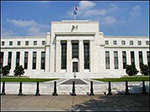by Pam Martens and Russ Martens, Wall St On Parade:

Katie Cox worked for the Federal Reserve for 32 years, the last two decades of which were spent overseeing complex proposals for bank mergers. She left the Fed in 2020.
Last Wednesday Katie Cox penned a shocker of a column for American Banker. She opened with this:
“Suppose you’re a crypto company that wants to own a bank approved to engage in digital-asset activities. Here’s the fast-track way you might achieve that, while complying with rules in place since August: Go buy a bank, any bank. Convert your bank to a Federal Reserve member bank, meaning that your bank’s federal supervisor will now be the Fed, not the Office of the Comptroller of the Currency or the Federal Deposit Insurance Corp. Wait a little bit, maybe six months. Then send the Fed a letter notifying it that your bank is going to engage in digital-asset activities and that you have determined the activities your bank will conduct are permissible. Promise that you will soon establish a risk management framework to manage this complex new business. If you’re lucky, your bank won’t be examined for a year or two. By then, you might have cranked up quite a dumpster fire.”
TRUTH LIVES on at https://sgtreport.tv/
Cox goes on to explain that she’s not recommending this as a strategy, but simply stating that crypto outfits have found a clever means of engaging in regulatory arbitrage. It should also be noted that Cox did not write this column out of an altruistic bent. She is one of a legion of former federal regulators that now work for crypto outfits. Cox now works as an advisor to Custodia Bank, a new applicant for Fed membership that wants to engage in crypto activities. According to Cox, new Fed applicants have a more difficult time than simply taking over an existing Fed member bank.
The August 16, 2022 rules put in place by the Fed are known as SR 22-6 and, indeed, leave it up to the bank to notify the Fed and have adequate risk management systems. But the Fed uses the word “should” do this or that throughout this rule instead of “must.” Lots of dumpster fires have ensued.
The Fed also makes this statement in rule SR 22-6: “Given the heightened and novel risks posed by crypto-assets, the Federal Reserve is closely monitoring related developments and banking organizations’ participation in crypto-asset-related activities.” Monitoring is, clearly, not the same thing as policing.
Twelve days after the disgraced and corrupt crypto exchange, FTX, filed for bankruptcy, the New York Times ran this headline: “Crypto Firm FTX’s Ownership of a U.S. Bank Raises Questions.” The article explains that a tiny bank in Washington state, Farmington State Bank (also known as Moonstone Bank), had received an ownership stake of $11.5 million from FTX’s sister firm, Alameda Research, which at the time was twice the net worth of the bank. The Federal Reserve is the primary regulator of Farmington State Bank according to regulatory filings.
Sam Bankman-Fried, who was indicted on eight criminal counts by the U.S. Department of Justice yesterday, is the majority owner of both FTX and Alameda Research, the hedge fund he operated as a personal piggy bank using customer deposits from FTX. Attorney General Merrick Garland had this to say about Sam Bankman-Fried yesterday:
“We allege that the defendant conspired to defraud customers by misappropriating their deposits; to defraud lenders; to commit securities fraud and money laundering; and to violate campaign finance laws. As this indictment demonstrates, the U.S. Department of Justice will aggressively investigate and prosecute alleged criminal wrongdoing in the financial system and violations of federal elections laws. We will continue to work to ensure U.S. capital markets operate honestly and with the integrity that investors, lenders, and the American people are entitled to.”
The American people are the taxpayers that are now picking up the tab for the Justice Department, the Securities and Exchange Commission, the Commodity Futures Trading Commission and a multitude of state regulators to investigate what appears to be a global fraud perpetrated by FTX and its affiliates. That the alleged kingpin of this fraud, Sam Bankman-Fried, was so easily able to obtain an ownership stake in a federally-insured bank means the Fed needs to move beyond “monitoring” the banks it oversees and into the aggressive role of cop on the beat.
Farmington State Bank is not the only bank whose primary regulator is the Federal Reserve and that is feeling the fallout from the collapse of FTX. Silvergate Bank is also primarily supervised by the Fed and experiencing a mountain of pain. Its publicly-traded parent, Silvergate Capital Corp. (ticker SI), closed at $148.20 on December 31, 2021. The stock closed yesterday at $18.73, a decline of 11.9 percent on the day and a plunge of 87 percent year-to-date.
That’s not the kind of performance that breeds confidence in the safety and soundness of U.S. banks and how they are supervised by the Fed.
Silvergate Capital’s 10-K (annual report) for the year ending Dec 31, 2021 states that “Deposits from digital currency exchanges represent approximately 58.0% of the Bank’s overall deposits and are held by approximately 94 exchanges.”
Approximately $1 billion of those deposits at Silvergate Bank came from FTX – meaning that this federally-insured bank has now brought – at a minimum – serious reputational damage on itself and its wimpy cop, the Federal Reserve.
Two Senators who sit on the Senate Banking Committee are taking serious note of this situation. Senator Elizabeth Warren (D-MA) and Senator Tina Smith (D-MN) sent a letter last Wednesday to Jerome Powell, Chair of the Federal Reserve; Martin Gruenberg, Acting Chair of the Federal Deposit Insurance Corporation; and Michael Hsu, Acting Comptroller of the Office of the Comptroller of the Currency. The letter seeks answers on just how far crypto has encroached into the federally-insured banking system.
Read More @ WallStOnParade.com



